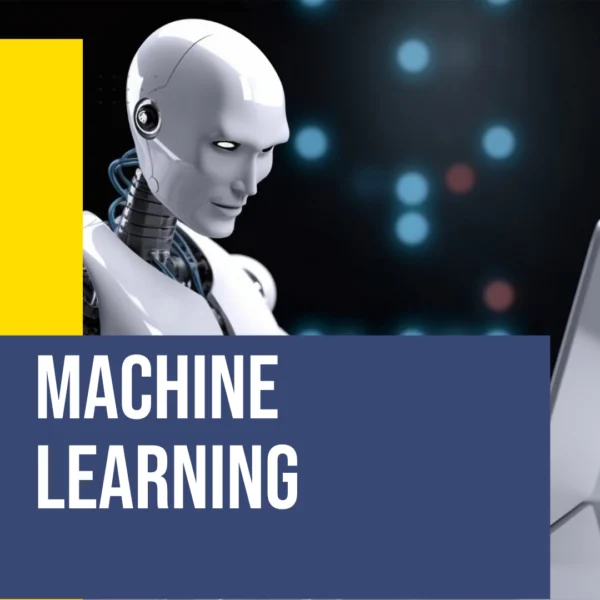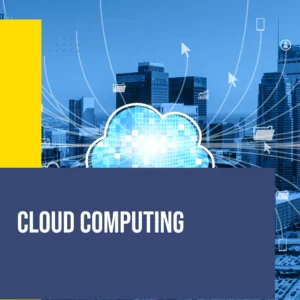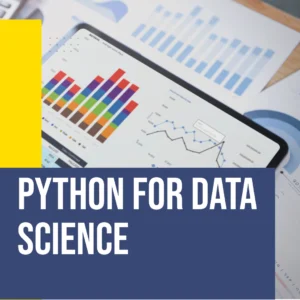Machine Learning
Original price was: ₹14,830.51.₹7,500.00Current price is: ₹7,500.00.
Description
Overview:
This comprehensive course covers the fundamentals of Machine Learning including supervised and unsupervised learning algorithms, model evaluation, feature engineering and more. Learn how to process and represent data, perform model evaluation, and feature engineering, and understand machine learning concepts. Discuss the future and impact of Machine Learning on society, including ethics and safety concerns. Gain a strong understanding of Machine Learning and its applications by the end of the course.
Prerequisites:
This curriculum of Machine Learning (Basic & Advance) course has been designed for all levels, regardless of your prior knowledge of analytics, statistics, or coding. Familiarity with mathematics is helpful for this course.
Key Learning Outcomes:
Upon completion of this course, students will be able to:
- Define machine learning and its different types (supervised and unsupervised) and understand their applications.
- Apply supervised learning algorithms, including linear regression, logistic regression, decision trees, random forests, support vector machines (SVMs), and k-nearest neighbours (k-NN).
- Implement unsupervised learning techniques, such as K-means clustering.
- Evaluate machine learning models and perform hyperparameter tuning to improve model performance.
- Perform feature engineering and dimensionality reduction techniques, such as feature extraction, feature selection, feature scaling, and PCA.
- Analyse the future and trends of machine learning, including its impact on society and the ethics and safety concerns associated with machine learning.
- Synthesize the concepts and techniques of machine learning into a comprehensive understanding of the field.
Target Audience:
This course is ideal for anyone who wishes to learn the details of data science and pursue a career in this growing field of Artificial Intelligence, Machine Learning, Deep Learning, Data Analytics & Data Science.
Test & Evaluation
- During the program, the participants will have to take all assignments given to them for better learning.
- At the end of the program, a final assessment will be conducted.
Certification
- All successful participants will be provided with a certificate of completion.
- Students who do not complete the course / leave it midway will not be awarded any certificate.
Delivery Mode & Duration:
Classroom Training – 120 Hours (60 Hours Classroom sessions + 60 Hours of assignment)
Online Live Mode – 120 Hours (60 Hours Online Live sessions + 60 Hours of assignment)
Module 01 – Machine Learning-Introduction
- Introduction of Machine Learning
- Evolution of Machine Learning
- Application of Machine Learning
Module 02 – Machine Learning in Different Sectors
- Introduction
- AI & ML for Products or Services
- How Google Uses Artificial Intelligence and Data Science
- How LinkedIn Uses Artificial Intelligence and Data Science
- How Amazon Uses Artificial Intelligence and Data Science
- Netflix: Using Artificial Intelligence and Data Science to Drive Engagement
- Media and Entertainment Industry
- Education Industry
- Healthcare Industry
- Government
- Weather Forecasting
- Key Takeaways
Module 03 – Machine Learning-Fundamental
- Difference between Traditional Programming and ML Programming
- Requirements for Machine Learning Practical Implementation
- Required software and tools for Machine Learning implementations.
- Setup Anaconda
- Installation of PyCharm or Spyder or Jupyter
- Configure PyCharm/Spyder/Jupyter with Anaconda
Module 04 – Python Programming Foundation for Data Science
- Introduction
- Variables
- Data Types with Python
- Assisted Practice: Data Types in Python
- Keywords and Identifiers
- Expressions
- Basic Operators
- Operators in Python
- Functions
- Search for a Specific Element from a Sorted List
- String Operations
- String Operations in Python
- Tuples
- Tuples in Python
- Lists
- Lists in Python
- Sets
- Sets in Python
- Dictionaries
- Dictionary in Python
- Dictionary and its Operations
- Conditions and Branching
- While Loop
- For Loop
- Break and Continue Statements
Module 05 – File handling and Package handling using Python.
- Learning Objectives
- File Handling
- File Opening and Closing
- Reading and Writing Files
- Directories in File Handling
- Assisted Practice: File Handling
- Modules and Packages
- Assisted Practice: Package Handling
Module 06 – Mathematical Computing using NumPy
- Learning objectives
- Introduction of NumPy
- Create and Print Numpy Arrays
- Operations
- Executing Basic Operations in Numpy Array
- Performing Operations Using Numpy Array
- Demonstrate the Use of Copy and Use
- Manipulate the Shape of an Array
Module 07 – Data Manipulation with Pandas
- Learning Objectives
- Introduction to Pandas
- Data Structures
- Create Pandas Series
- DataFrame
- Create Pandas DataFrames
- Missing Values
- Handle Missing Values
- Various Data Operations
- Data Operations in Pandas DataFrame
Module 8 – Data visualization with Python
- Learning objectives
- Data Visualization
- Considerations of Data Visualization
- Factors of Data Visualization
- Python Libraries
- Create Your First Plot Using Matplotlib
- Line Properties
- Multiple Plots and Subplots
- Create a Plot with Annotation
- Create Multiple Subplots Using plt.subplots
- Types of plots
- Create a Stacked Histogram
- Create a Scatter Plot
- Create a Pie Chart
- Create a Bar Chart
- Create Box Plots
- Analysing Variables Individually
- Key Takeaways
Module 9 – Steps of Machine Learning Implementations
- Types of Machine Learning
- Labelled Data and Unlabelled Data
- Steps of Machine Learning
- Concept of Collecting the historic training Data for ML
- Concept of Pre-process data for Machine Learning
- Concept of Train the ML model
- Concept of Test the ML Algorithm
- Concept of using the ML Algorithm
Module 10 – Data Collection for Machine Learning
- Introduction
- Types of Data collection- Offline Data and Online Data
- Practical implementations of Reading the offline dataset using Numpy
- Practical implementations of Reading the online dataset using Numpy
- Practical implementations of Reading the offline dataset using Pandas
- Practical implementations of Reading the online iris dataset using Pandas
Module 11 – Concept of Supervise & Unsupervised Machine Learning
- Introduction
- Types of Machine Learning
- Labelled Data and Unlabeled Data
- Concept of Supervised Machine Learning
- Concept of Unsupervised Machine Learning
- Regression and Classification
- Linear Regression and Logistic Regression
Module 12 – Data Plotting for Machine Learning
- Introduction
- Concept of Univariate plots
- Univariate Histogram Plots.
- Univariate Density Plots.
- Univariate Box and Whisker Plots.
- Concept of Multivariate plots
- Correlation Matrix Plot
- Scatter Matrix Plot
Module 13 – Prepare Data for ML using Data Transformation Methods
- Introduction
- Need for Data Pre-processing
- Data Transforms Steps
- Types of Data Transformation Methods
- Rescale Data
- Standardize Data
- Normalize Data
- Binarize Data
Module 14 – Practical implementation of Supervised ML Algorithm
- Introduction
- Implementation Foundation of Supervised Machine Learning Algorithms
- Regression and Classification
- Linear Regression and Logistic Regression
- Practical implementations of Supervised ML Algorithms- Linear Regression
- Practical implementations of Supervised ML Algorithms- Logistic Regression
- Concept of Sigmoid Function
- k-NN Algorithm
- Naive Bayes Classifiers
- Decision trees etc.
- Concept of Support vector machines
- Introduction to concepts of forecasting
Module 15 – Data Resampling Methods for Evaluation of ML Models
- Introduction
- Evaluate Machine Learning Algorithms
- Split into Train and Test Sets
- K-fold Cross Validation
- Leave One Out Cross Validation
- Repeated Random Test-Train Splits
- What Techniques to Use When
Module 16 – Machine Learning Algorithm Performance Evaluation Metrics
- Introduction
- Algorithm Evaluation Metrics
- Logistic Regression Algorithm Performance Evaluation Metrics
- Classification Accuracy (Default).
- Logarithmic Loss.
- Area Under ROC Curve (AUC).
- Confusion Matrix.
- Classification Report.
- Linear Regression Algorithm Performance Evaluation Metrics
- Mean Absolute Error.
- Mean Squared Error.
- R2 Error
Module 17 – Practical implementation of Unsupervised Machine Learning
- Introduction
- Concepts and Steps of Unsupervised Machine Learning Algorithm
- Concept of Clustering,
- Practical implementations of Machine Learning Unsupervised Algorithms
- K-Means Clustering.
Module 18 – Spot-Check Machine Learning Algorithms
- Concept of Algorithm Spot-Checking
- Algorithms Overview
- Linear Machine Learning Algorithms Spot-check
- Nonlinear Machine Learning Algorithms Spot-check
Module 19 – Save and Load Machine Learning Models
- Introduction
- Finalize Your Model with pickle.
- Finalize Your Model with Joblib
Module 20 – Conclusion and Future of Machine Learning
- Summary of machine learning concepts and techniques
- Machine learning trends and future developments
- Machine learning and society
- Machine learning ethics and safety.
You can also give us a call on Mobile +91-9335469335





